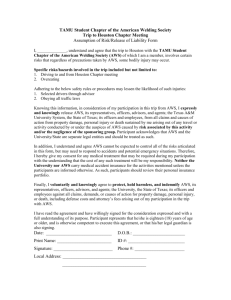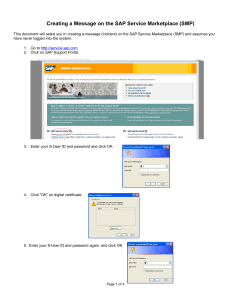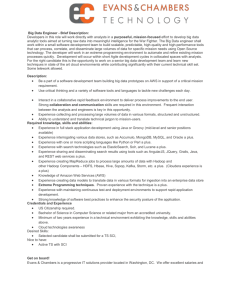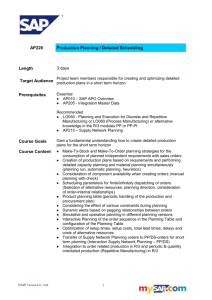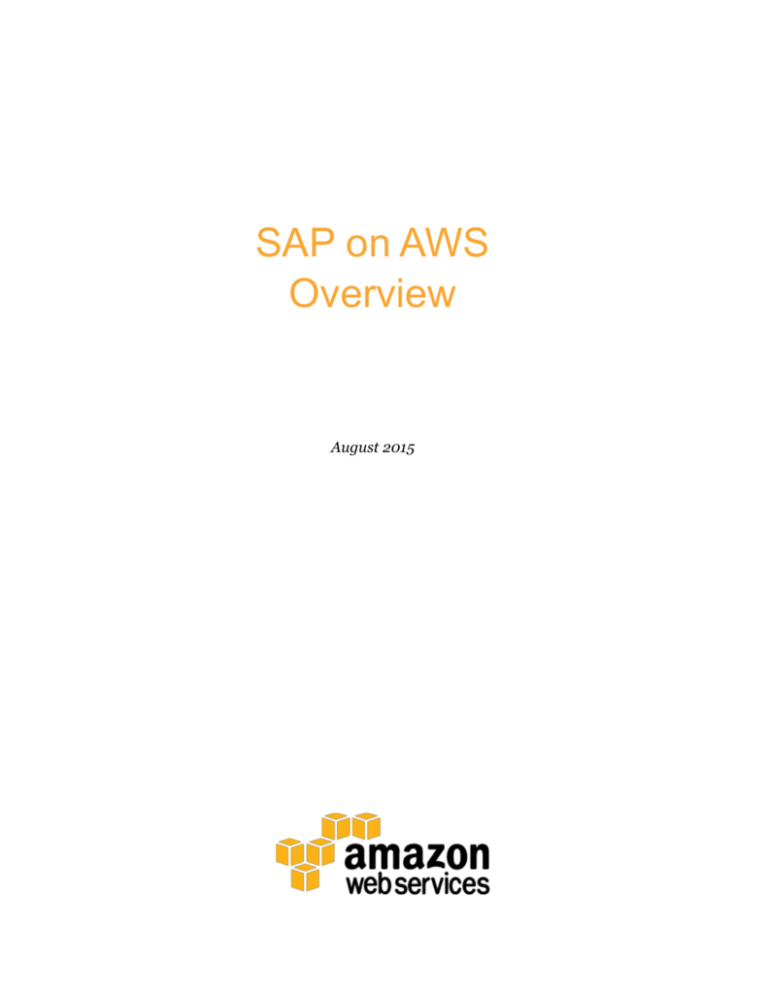
SAP on AWS
Overview
August 2015
Amazon Web Services – SAP on AWS Overview
August 2015
© 2015, Amazon Web Services, Inc. or its affiliates. All rights reserved.
Notices
This document is provided for informational purposes only. It represents AWS’s
current product offerings and practices as of the date of issue of this document,
which are subject to change without notice. Customers are responsible for
making their own independent assessment of the information in this document
and any use of AWS’s products or services, each of which is provided “as is”
without warranty of any kind, whether express or implied. This document does
not create any warranties, representations, contractual commitments, conditions
or assurances from AWS, its affiliates, suppliers or licensors. The responsibilities
and liabilities of AWS to its customers are controlled by AWS agreements, and
this document is not part of, nor does it modify, any agreement between AWS
and its customers.
Page 2 of 13
Amazon Web Services – SAP on AWS Overview
August 2015
Contents
Abstract
4
AWS Overview
4
Global Infrastructure
4
AWS Security and Compliance
5
AWS Products and Services
5
SAP on AWS
Page 3 of 13
6
AWS and SAP Alliance
6
Benefits of Running SAP on AWS
7
SAP Support on AWS
7
SAP on AWS Use Cases
8
SAP on AWS Case Studies
9
SAP Licensing on AWS
9
Managed Services for SAP on AWS
9
SAP System Deployment
10
SAP HANA on AWS
11
Pricing SAP on AWS
12
Additional Information
12
Contributors
12
Notes
12
Amazon Web Services – SAP on AWS Overview
August 2015
Abstract
Companies of all sizes can take advantage of the many benefits provided by
Amazon Web Services (AWS) to achieve business agility, cost savings, and high
availability by running their SAP environments on the AWS cloud.
This guide is intended for SAP customers and partners who want to learn about
the benefits and options for running SAP solutions on AWS, or who want to know
how to implement and operate their SAP environment effectively on AWS.
AWS Overview
Amazon Web Services (AWS) provides on-demand computing resources and
services in the cloud, with pay-as-you-go pricing. You can run a server on AWS
and log in, configure, secure, and operate it just as you would operate a server in
your own data center.
Using AWS resources for your compute needs is like purchasing electricity from a
power company instead of running your own generator, and it provides many of
the same benefits:
The capacity you get exactly matches your needs.
You pay only for what you use.
Economies of scale result in lower costs.
The service is provided by a vendor who is experienced in running largescale compute and network systems.
Global Infrastructure
AWS is built on a global infrastructure. AWS services are available to use in
different geographical regions. AWS regions enable you to deploy your SAP
environment in a location that is closer to your users, and to meet legal or other
requirements. Regions are isolated from one another, and AWS does not replicate
your resources or data across regions automatically.
Each region contains multiple distinct locations called Availability Zones. Each
Availability Zone is engineered to be isolated from failures in other Availability
Page 4 of 13
Amazon Web Services – SAP on AWS Overview
August 2015
Zones, and to provide inexpensive, low-latency network connectivity to other
zones in the same region.
AWS is currently available in 11 regions and 30 Availability Zones in the United
States, Brazil, Europe, Japan, Singapore, Australia, and China. For additional
information about AWS regions and Availability Zones, see the AWS Global
Infrastructure webpage.1
AWS Security and Compliance
The AWS cloud security infrastructure has been architected to be one of the most
flexible and secure cloud computing environments available today. Security on
AWS is very similar to security in your on-premises data center—but without the
costs and complexities involved in protecting facilities and hardware. AWS
provides a secure global infrastructure, plus a range of features that you can use
to help secure your systems and data in the cloud. To learn more about AWS
Security, visit the AWS Security Center.2
AWS Compliance enables customers to understand the robust controls in place at
AWS to maintain security and data protection in the cloud. AWS engages with
external certifying bodies and independent auditors to provide customers with
extensive information regarding the policies, processes, and controls established
and operated by AWS. To learn more about AWS Compliance, visit the AWS
Compliance Center.3
AWS Products and Services
AWS provides an extensive set of computing resources and services. The
following sections provide an overview of the core AWS services that are most
relevant for the implementation and operation of SAP solutions.
Compute
Amazon Elastic Compute Cloud (Amazon EC2) provides scalable computing
capacity in the AWS cloud.4 Amazon EC2 offers a wide selection of virtual
machine configurations that support different CPU, memory, network, and I/O
capabilities. For running SAP systems, Amazon EC2 provides virtual machine
instances for the Microsoft Windows Server, SUSE Linux Enterprise Server, and
Red Hat Enterprise Linux operating systems.
Page 5 of 13
Amazon Web Services – SAP on AWS Overview
August 2015
Storage
Amazon Elastic Block Store (Amazon EBS) provides persistent block level storage
volumes for use with Amazon EC2 instances.5 Amazon EBS volumes are highly
available and reliable storage volumes that can be attached to any running
instance. Amazon EBS volumes that are attached to an Amazon EC2 instance are
exposed as storage volumes that persist independently from the lifetime of the
instance. Amazon EBS volumes are designed for 99.999% availability.
Amazon Simple Storage Service (Amazon S3) provides access to reliable, fast, and
inexpensive data storage infrastructure.6 Amazon S3 stores data objects
redundantly on multiple devices across multiple facilities. This service provides
highly available and highly durable backup storage for your SAP systems on
AWS.
Networking
Amazon Virtual Private Cloud (Amazon VPC) enables you to define a virtual
network in your own logically isolated area within the AWS cloud.7 Your Amazon
VPC closely resembles a traditional network that you might operate in your own
data center, but it includes the benefits of using the AWS scalable infrastructure.
You can connect your Amazon VPC to your own corporate data center to provide
seamless integration between on-premises users and systems, and SAP systems
in your Amazon VPC.
Deployment and Management
The AWS Management Console provides a simple and intuitive web-based
interface for provisioning and managing AWS resources.8
AWS CloudFormation gives you an easy way to create and manage a collection of
related AWS resources, and provision and update them in an orderly and
predictable fashion.9
SAP on AWS
AWS and SAP Alliance
SAP has been an AWS customer since 2008 and uses the AWS infrastructure for
a variety of use cases and scenarios. In early 2011, AWS became an SAP Global
Page 6 of 13
Amazon Web Services – SAP on AWS Overview
August 2015
Technology Partner. Since then, AWS has worked closely with SAP to test and
certify the AWS cloud for SAP solutions.
Benefits of Running SAP on AWS
Lower TCO ― Benefit from the economies of scale and efficiencies provided by
AWS. Pay for only the compute, storage, and other resources you use. Read about
savings of up to 71% compared to running SAP systems on premises.10
Reaplce CapEx with OpEx ― Start an SAP implementation or project on AWS
without any upfront cost or commitment for compute, storage, or network
infrastructure.
Agility and speed ― Provision new infrastructure and SAP systems in minutes
compared to waiting weeks or months to procure and deploy traditional
infrastructure.
Flexibility ― The AWS cloud supports standard Windows Server, SUSE Linux
Enterprise Server, and Red Hat Enterprise Linux, providing many options for
installing SAP solutions.
Stop guessing capacity ― Eliminate guesswork on your SAP infrastructure
capacity needs. With AWS you can access as much or as little capacity as you
need, and scale up and down as required in only a few minutes.
SAP Support on AWS
Supported Solutions
AWS and SAP have worked together to test and certify the following SAP
solutions to be fully supported for production deployment on AWS.
Page 7 of 13
Amazon Web Services – SAP on AWS Overview
August 2015
SAP Business Suite
SAP BusinessObjects
SAP HANA
SAP Afaria
SAP Business All-in-One
SAP Mobile Platform
SAP NetWeaver
SAP Business One
SAP ASE
SAP Rapid Deployment Solutions
SAP IQ
SAP Replication Server
For additional information about SAP solutions supported on AWS, see SAP Note
1656099 (SAP Support Portal login required).11
SAP Support
SAP provides the same level of product support for SAP systems running on AWS
that it does on any other infrastructure. Full support of SAP production systems
running on AWS requires AWS Business-level or Enterprise-level support.
For additional information about AWS Support, see
http://aws.amazon.com/premiumsupport/.
For additional information about SAP support on AWS, see SAP Note 1656250
(SAP Support Portal login required).12
SAP on AWS Use Cases
SAP customers and partners are using AWS for a wide range of use cases,
including the following:
Page 8 of 13
Migration of existing SAP production environments to AWS
Implementation of new SAP production environments on AWS
Migration of existing SAP DEV and QAS landscapes to AWS
Running SAP test, training, demo, and POC systems on AWS
Evaluation and testing of new SAP solutions
SAP document and data archiving on AWS
Disaster recovery for on-premises SAP environments
Temporary infrastructure for SAP upgrades and OS/DB migrations
Amazon Web Services – SAP on AWS Overview
August 2015
Archival of complete SAP legacy systems
SAP on AWS Case Studies
SAP customers of all sizes are taking advantage of the benefits provided by AWS.
To read about SAP customers who have achieved business agility, cost savings,
and high availability by running their SAP environments on the AWS cloud, see
SAP on AWS Case Studies.13
SAP Licensing on AWS
Bring Your Own License
Most SAP solutions use a Bring Your Own License (BYOL) model on AWS for the
SAP software components and underlying databases. SAP customers and
partners can use new or existing SAP licenses for systems running on Amazon
EC2.
On-Demand, Trial, and Developer Licenses
Some SAP solutions are available on Amazon EC2 with on-demand, trial, or
developer licenses. For a list of the SAP solutions that are currently available
with one of these license types, see the SAP on AWS website.14
Operating System Licenses
Operating system licenses are included in the hourly fee of Amazon EC2
instances.
Managed Services for SAP on AWS
The provisioning and management of AWS resources are completely self-service.
Maintenance and administration of the operating system and any applications
and databases running above the operating system are managed by the customer.
AWS manages the underlying hardware, software, networking, and facilities that
run AWS services up to the virtualization layer.
If a managed service is required, AWS has a network of partners that can provide
a fully managed hosting service for SAP solutions on top of AWS. To learn more
about services for SAP on AWS and to find an SAP partner within the AWS
Partner Network, see http://aws.amazon.com/sap/find-partners/.
Page 9 of 13
Amazon Web Services – SAP on AWS Overview
August 2015
The following diagram depicts the two most common scenarios for managing
SAP on AWS:
SAP System Deployment
Deployment of an SAP system on AWS is very similar to the deployment process
on traditional infrastructure. AWS also offers innovative deployment options
that greatly reduce the effort and time to deploy a new SAP environment.
SAP standard installation – The primary deployment method for most SAP
solutions on AWS uses a Bring Your Own Software model using the standard SAP
installation processes and tools. Installation of an SAP solution on AWS is very
similar to the process of installing SAP on any other physical or virtual server.
AWS Quick Start reference deployment – AWS Quick Start reference
deployments help you rapidly deploy fully functional enterprise software on the
AWS cloud. With each Quick Start you can easily launch, configure, and run
AWS compute, networking, storage, and other services to deploy that workload
on AWS, often in an hour or less.
Page 10 of 13
Amazon Web Services – SAP on AWS Overview
August 2015
Prebuilt SAP system image – Some SAP solutions are available on AWS as a
prebuilt system image that contains a preinstalled and preconfigured SAP
system. A prebuilt SAP system image enables you to rapidly provision a new SAP
system without spending the time and effort required by a traditional manual
SAP installation.
For additional information about the available options for deploying SAP on
AWS, see the SAP on AWS Implementation and Operations Guide.15
SAP HANA on AWS
AWS has worked closely with SAP to certify the AWS platform so that companies
of all sizes can fully realize all the benefits of the SAP HANA in-memory database
management system on the AWS cloud. The following offerings of SAP HANA
are currently available on AWS:
SAP HANA Infrastructure Services – AWS infrastructure for the deployment and
operation of SAP HANA solutions using a Bring Your Own License model and
providing up to 4 TB of total memory for certain SAP HANA scenarios.
SAP HANA One – A fully featured SAP HANA system, which is sold by SAP via
the AWS Marketplace with an on-demand or hourly SAP HANA license. SAP
HANA One is supported for production and non-production use cases.
SAP HANA Developer Edition – Free SAP HANA image with a perpetual SAP
HANA license for individual developers to build, test, and demo SAP HANA
applications.
SAP HANA Trials – Free trials of various SAP solutions running on SAP HANA
that can be rapidly provisioned on the AWS cloud.
For additional information about SAP HANA on AWS, see
http://aws.amazon.com/sap/solutions/saphana/.
Page 11 of 13
Amazon Web Services – SAP on AWS Overview
August 2015
Pricing SAP on AWS
With AWS you pay only for what you use—no upfront cost or long-term
commitment is required. To understand how to estimate the cost of running your
SAP environment on AWS, see the SAP on AWS Pricing Guide.16
Additional Information
For the latest information about SAP on AWS and to learn more about running
your SAP environment on AWS, see http://aws.amazon.com/sap.
If you have any questions about SAP on AWS, please contact us at
http://aws.amazon.com/sap/contact-us/.
Contributors
The following individuals and organizations contributed to this document:
Bill Timm, solutions architect, Amazon Web Services
Notes
Page 12 of 13
1
https://aws.amazon.com/about-aws/global-infrastructure/
2
http://aws.amazon.com/security/
3
http://aws.amazon.com/compliance/
4
http://aws.amazon.com/ec2/
5
http://aws.amazon.com/ebs/
6
http://aws.amazon.com/s3/
7
http://aws.amazon.com/vpc/
8
http://aws.amazon.com/console/
9
http://aws.amazon.com/cloudformation/
10
http://aws.amazon.com/whitepapers/vms-sap-tco/
11
http://service.sap.com/sap/support/notes/1656099
Amazon Web Services – SAP on AWS Overview
Page 13 of 13
August 2015
12
http://service.sap.com/sap/support/notes/1656250
13
http://aws.amazon.com/sap/case-studies/
14
http://aws.amazon.com/sap/getting-started/
15
http://d0.awsstatic.com/enterprisemarketing/SAP/SAP_on_AWS_Implementation_Guide.pdf
16
http://d0.awsstatic.com/enterprise-marketing/SAP/sap-on-aws-pricingguide.pdf



